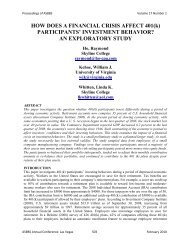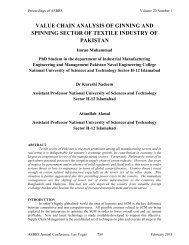stock repurchase announcements: a test of market ... - Asbbs.org
stock repurchase announcements: a test of market ... - Asbbs.org
stock repurchase announcements: a test of market ... - Asbbs.org
Create successful ePaper yourself
Turn your PDF publications into a flip-book with our unique Google optimized e-Paper software.
SUSTAINABLE GROWTH MODELING: A<br />
LONGITUDINAL ANALYSIS OF HARLEY-<br />
DAVIDSON, INC.<br />
Pickett, Michael C.<br />
National University<br />
mpickett@nu.edu<br />
ABSTRACT<br />
This paper presents an application <strong>of</strong> sustainable growth modeling presented by Van Horne. Van<br />
Horne (1998) has defined sustainable growth rate (SGR) as “...the maximum annual percentage<br />
increase in sales that can be achieved based on target operating, debt, and dividend-payout<br />
ratios” (p. 744).<br />
Harley-Davidson vice-president, Willie G. Davidson, in a Business Week magazine<br />
(Melcher, 1996) stated that, given the significant and unexpected increases in sales over the last<br />
few quarters, they plan to ship 200,000 motorcycles in the year 2003. However, this paper<br />
presents a dichotomy based on the company’s financial performance prior to the article’s<br />
publication and the articulated goals to provide a possible insight to the magic and mystique <strong>of</strong> a<br />
competitive <strong>market</strong>ing advantage.<br />
Historical financial date is analyzed to identify the subtle relationship between strategic<br />
<strong>market</strong>ing and maximizing operating efficiencies.<br />
INTRODUCTION<br />
According to Van Horne (1998, p. 743), “[t]he management <strong>of</strong> growth requires careful balancing<br />
<strong>of</strong> the sales objectives <strong>of</strong> the firm with its operating efficiency and financial resources”.<br />
Additionally, Van Horne (1998) argues the “...trick is to determine what sales growth rate is<br />
constant with the realities <strong>of</strong> the company and <strong>of</strong> the financial <strong>market</strong>place” (p. 743). The<br />
“realities” Van Horne mentions, according to H. Igor Ans<strong>of</strong>f, from a strategic management<br />
perspective can be calculated, in contrast, Henry Mintzberg argued that <strong>org</strong>anizations are unable<br />
to calculate turbulent cycles (Academy <strong>of</strong> Management, 1998). Regardless, financial managers<br />
still need to identify opportunities to forecast growth potential <strong>of</strong> a company.<br />
The purpose <strong>of</strong> this paper is comparative and longitudinal in nature. A financial analysis<br />
technique known as sustainable growth modeling (Van Horne, 1998) will be applied to Harley-<br />
Davidson, Inc. Initially this methodology was proposed as a “litmus <strong>test</strong>” to identify if the<br />
specific target proposed by the company <strong>of</strong> an output goal <strong>of</strong> 200,000 motorcycles by 2003 was a<br />
feasible endeavor; however, when applied over a period <strong>of</strong> 10 years, the sustainable growth rate<br />
model provides greater insights into the mystique <strong>of</strong> the American-made motorcycle created by<br />
four men in 1903.<br />
BACKGROUND<br />
Harley-Davidson, Inc, as the focus <strong>of</strong> this research, exists as an American producer in a<br />
seemingly never-ending sea <strong>of</strong> imports. The focus on growth within a specific <strong>market</strong> espouses<br />
concepts from two very distinct, yet related areas in literature; financial growth and <strong>market</strong>ing.<br />
GROWTH MODELS<br />
ASBBS E-Journal, Volume 4, No.1, 2008 171

















